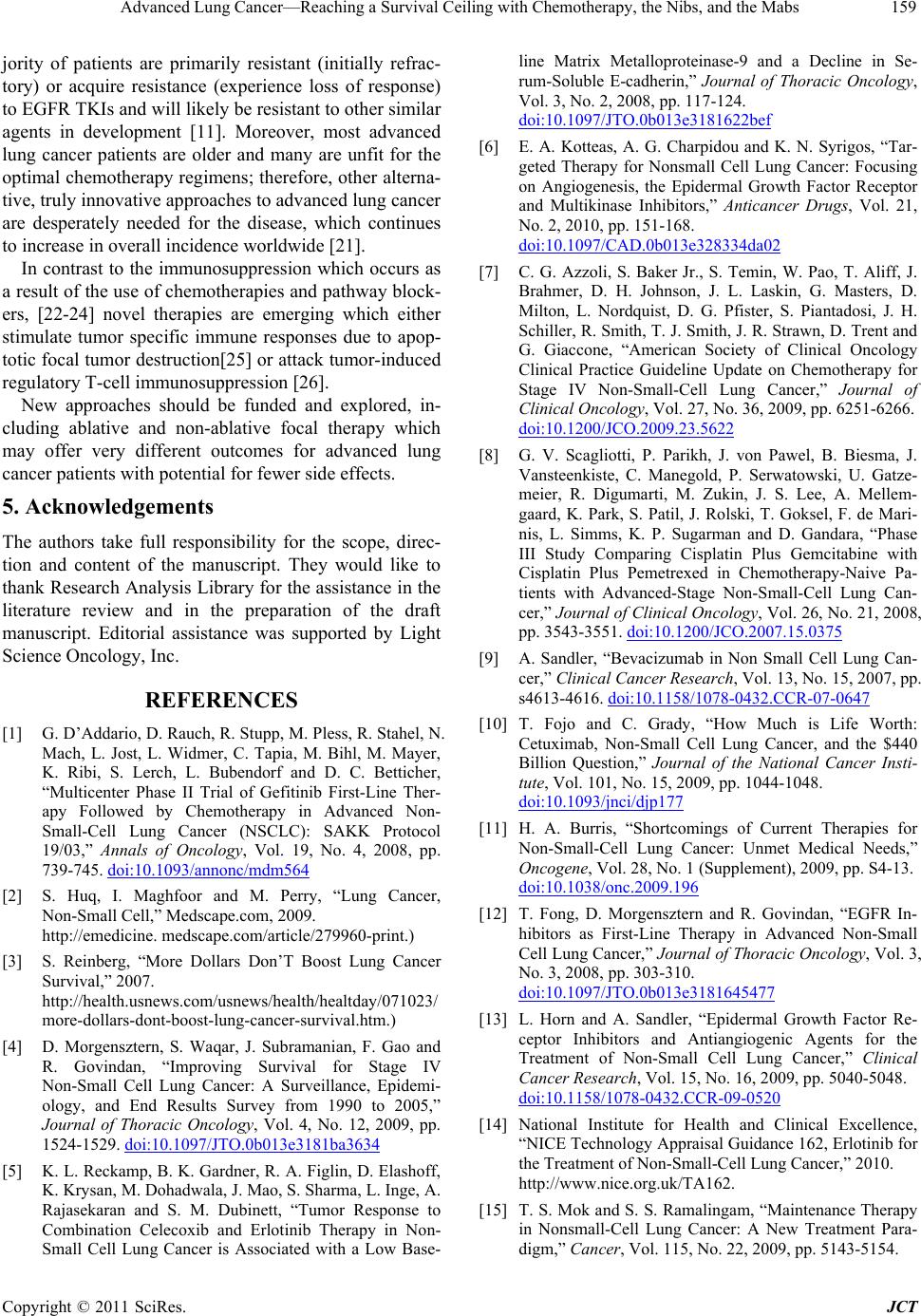
Advanced Lung Cancer—Reaching a Survival Ceiling with Chemotherapy, the Nibs, and the Mabs159
jority of patients are primarily resistant (initially refrac-
tory) or acquire resistance (experience loss of response)
to EGFR TKIs and will likely be resistant to other similar
agents in development [11]. Moreover, most advanced
lung cancer patients are older and many are unfit for the
optimal chemotherapy regimens; therefore, other alterna-
tive, truly innovativ e ap pro ach es to adv anced lung cancer
are desperately needed for the disease, which continues
to increase in overall incidence worldwide [21].
In contrast to the immunosuppression which occurs as
a result of the use of chemotherapies and pathway block-
ers, [22-24] novel therapies are emerging which either
stimulate tumor specific immune responses due to apop-
totic focal tumor destruction[25 ] or attack tumor-induced
regulatory T-cell immunosuppression [26].
New approaches should be funded and explored, in-
cluding ablative and non-ablative focal therapy which
may offer very different outcomes for advanced lung
cancer patients with potential for fewer side effects.
5. Acknowledgements
The authors take full responsibility for the scope, direc-
tion and content of the manuscript. They would like to
thank Res earch Analysis Library for the assistance in the
literature review and in the preparation of the draft
manuscript. Editorial assistance was supported by Light
Science Oncology, Inc.
REFERENCES
[1] G. D’Addario, D. Rauch, R. Stupp, M. Pless, R. Stahel, N.
Mach, L. Jost, L. Widmer, C. Tapia, M. Bihl, M. Mayer,
K. Ribi, S. Lerch, L. Bubendorf and D. C. Betticher,
“Multicenter Phase II Trial of Gefitinib First-Line Ther-
apy Followed by Chemotherapy in Advanced Non-
Small-Cell Lung Cancer (NSCLC): SAKK Protocol
19/03,” Annals of Oncology, Vol. 19, No. 4, 2008, pp.
739-745. doi:10.1093/annonc/mdm564
[2] S. Huq, I. Maghfoor and M. Perry, “Lung Cancer,
Non-Small Cell,” Medscape.com, 2009.
http://emedicine. medscape.com/article/279960-print.)
[3] S. Reinberg, “More Dollars Don’T Boost Lung Cancer
Survival,” 2007.
http://health.usnews.com/usnews/health/healtday/071023/
more-dollars-dont-boost-lung-cancer-survival.htm.)
[4] D. Morgensztern, S. Waqar, J. Subramanian, F. Gao and
R. Govindan, “Improving Survival for Stage IV
Non-Small Cell Lung Cancer: A Surveillance, Epidemi-
ology, and End Results Survey from 1990 to 2005,”
Journal of Thoracic Oncology, Vol. 4, No. 12, 2009, pp.
1524-1529. doi:10.1097/JTO.0b013e3181ba3634
[5] K. L. Reckamp, B. K. Gardner, R. A. Figlin, D. Elashoff,
K. Krysan, M. Dohadwala, J. Mao, S. Sharma, L. Inge, A.
Rajasekaran and S. M. Dubinett, “Tumor Response to
Combination Celecoxib and Erlotinib Therapy in Non-
Small Cell Lung Cancer is Associated with a Low Base-
line Matrix Metalloproteinase-9 and a Decline in Se-
rum-Soluble E-cadherin,” Journal of Thoracic Oncology,
Vol. 3, No. 2, 2008, pp. 117-124.
doi:10.1097/JTO.0b013e3181622bef
[6] E. A. Kotteas, A. G. Charpidou and K. N. Syrigos, “Tar-
geted Therapy for Nonsmall Cell Lung Cancer: Focusing
on Angiogenesis, the Epidermal Growth Factor Receptor
and Multikinase Inhibitors,” Anticancer Drugs, Vol. 21,
No. 2, 2010, pp. 151-168.
doi:10.1097/CAD.0b013e328334da02
[7] C. G. Azzoli, S. Baker Jr., S. Temin, W. Pao, T. Aliff, J.
Brahmer, D. H. Johnson, J. L. Laskin, G. Masters, D.
Milton, L. Nordquist, D. G. Pfister, S. Piantadosi, J. H.
Schiller, R. Smith, T. J. Smith, J. R. Strawn, D. Trent and
G. Giaccone, “American Society of Clinical Oncology
Clinical Practice Guideline Update on Chemotherapy for
Stage IV Non-Small-Cell Lung Cancer,” Journal of
Clinical Oncology, Vol. 27, No. 36, 2009, pp. 6251-6266.
doi:10.1200/JCO.2009.23.5622
[8] G. V. Scagliotti, P. Parikh, J. von Pawel, B. Biesma, J.
Vansteenkiste, C. Manegold, P. Serwatowski, U. Gatze-
meier, R. Digumarti, M. Zukin, J. S. Lee, A. Mellem-
gaard, K. Park, S. Patil, J. Rolski, T. Goksel, F. de Mari-
nis, L. Simms, K. P. Sugarman and D. Gandara, “Phase
III Study Comparing Cisplatin Plus Gemcitabine with
Cisplatin Plus Pemetrexed in Chemotherapy-Naive Pa-
tients with Advanced-Stage Non-Small-Cell Lung Can-
cer,” Journal of Clinical Oncology, Vol. 26, No. 21, 2008,
pp. 3543-3551. doi:10.1200/JCO.2007.15.0375
[9] A. Sandler, “Bevacizumab in Non Small Cell Lung Can-
cer,” Clinical Cancer Research, Vol. 13, No. 15, 2007, pp.
s4613-4616. doi:10.1158/1078-0432.CCR-07-0647
[10] T. Fojo and C. Grady, “How Much is Life Worth:
Cetuximab, Non-Small Cell Lung Cancer, and the $440
Billion Question,” Journal of the National Cancer Insti-
tute, Vol. 101, No. 15, 2009, pp. 1044-1048.
doi:10.1093/jnci/djp177
[11] H. A. Burris, “Shortcomings of Current Therapies for
Non-Small-Cell Lung Cancer: Unmet Medical Needs,”
Oncogene, Vol. 28, No. 1 (Supplement), 2009, pp. S4-13.
doi:10.1038/onc.2009.196
[12] T. Fong, D. Morgensztern and R. Govindan, “EGFR In-
hibitors as First-Line Therapy in Advanced Non-Small
Cell Lung Cancer,” Journal of Thoracic Oncology, Vol. 3,
No. 3, 2008, pp. 303-310.
doi:10.1097/JTO.0b013e3181645477
[13] L. Horn and A. Sandler, “Epidermal Growth Factor Re-
ceptor Inhibitors and Antiangiogenic Agents for the
Treatment of Non-Small Cell Lung Cancer,” Clinical
Cancer Research, Vol. 15, No. 16, 2009, pp. 5040-5048.
doi:10.1158/1078-0432.CCR-09-0520
[14] National Institute for Health and Clinical Excellence,
“NICE Technology Appraisal Guidance 162, Erlotinib for
the Treatment of Non-Small-Cell Lung Cancer,” 2010.
http://www.nice.org.uk/TA162.
[15] T. S. Mok and S. S. Ramalingam, “Maintenance Therapy
in Nonsmall-Cell Lung Cancer: A New Treatment Para-
digm,” Cancer, Vol. 115, No. 22, 2009, pp. 5143-5154.
Copyright © 2011 SciRes. JCT